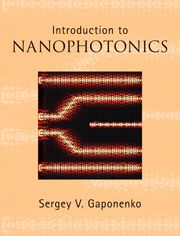Crossref Citations
This Book has been
cited by the following publications. This list is generated based on data provided by Crossref.
Ozel, Tuncay
Nizamoglu, Sedat
Sefunc, Mustafa A.
Samarskaya, Olga
Ozel, Ilkem O.
Mutlugun, Evren
Lesnyak, Vladimir
Gaponik, Nikolai
Eychmuller, Alexander
Gaponenko, Sergey V.
and
Demir, Hilmi Volkan
2010.
Observation of anisotropic emission from semiconductor quantum dots in nanocomposites of metal nanoparticles.
p.
144.
Novitsky, Denis V.
2011.
Spectral transformations in the regime of pulse self-trapping in a nonlinear photonic crystal.
Physical Review A,
Vol. 84,
Issue. 5,
Klyachkovskaya, Elena
Strekal, Natalia
Motevich, Inna
Vaschenko, Svetlana
Harbachova, Anna
Belkov, Mikhail
Gaponenko, Sergey
Dais, Christian
Sigg, Hans
Stoica, Toma
and
Grützmacher, Detlev
2011.
Enhanced Raman Scattering of Ultramarine on Au-coated Ge/Si-nanostructures.
Plasmonics,
Vol. 6,
Issue. 2,
p.
413.
Ozel, Tuncay
Nizamoglu, Sedat
Sefunc, Mustafa A.
Samarskaya, Olga
Ozel, Ilkem O.
Mutlugun, Evren
Lesnyak, Vladimir
Gaponik, Nikolai
Eychmuller, Alexander
Gaponenko, Sergey V.
and
Demir, Hilmi Volkan
2011.
Anisotropic Emission from Multilayered Plasmon Resonator Nanocomposites of Isotropic Semiconductor Quantum Dots.
ACS Nano,
Vol. 5,
Issue. 2,
p.
1328.
Zambrana, Xavier
and
Molina-Terriza, Gabriel
2011.
Control of optical resonances in dielectric spheres using Laguerre-Gaussian beams.
p.
1814.
Meixner, Alfred J
2011.
Nanophotonics, nano-optics and nanospectroscopy.
Beilstein Journal of Nanotechnology,
Vol. 2,
Issue. ,
p.
499.
Mackowski, Daniel W.
and
Mishchenko, Michael I.
2011.
Direct simulation of multiple scattering by discrete random media illuminated by Gaussian beams.
Physical Review A,
Vol. 83,
Issue. 1,
Ponyavina, A. N.
and
Kachan, S. M.
2011.
Polarimetric Detection, Characterization and Remote Sensing.
p.
383.
Kulakovich, O. S.
Strekal, N. D.
and
Artemyev, M. V.
2011.
Production of colloidal nanostructures for optical and spectral-analytic applications.
Journal of Applied Spectroscopy,
Vol. 78,
Issue. 1,
p.
81.
Karamaliyev, R. A.
and
Qajar, Ch. O.
2012.
Optical properties of composite thin films containing silver nanoparticles.
Journal of Applied Spectroscopy,
Vol. 79,
Issue. 3,
p.
404.
Baldycheva, Anna
Tolmachev, Vladimir A
Berwick, Kevin
and
Perova, Tatiana S
2012.
Multi-channel Si-liquid crystal filter with fine tuning capability of individual channels for compensation of fabrication tolerances.
Nanoscale Research Letters,
Vol. 7,
Issue. 1,
Klingshirn, Claus F.
2012.
Semiconductor Optics.
p.
249.
Klyachkovskaya, E. V.
Guzatov, D. V.
Strekal, N. D.
Vaschenko, S. V.
Harbachova, A. N.
Belkov, M. V.
and
Gaponenko, S. V.
2012.
Enhancement of Raman scattering of light by ultramarine microcrystals in presence of silver nanoparticles.
Journal of Raman Spectroscopy,
Vol. 43,
Issue. 6,
p.
741.
Klingshirn, Claus F.
2012.
Semiconductor Optics.
p.
1.
Guzatov, Dmitry V.
Vaschenko, Svetlana V.
Stankevich, Vyacheslav V.
Lunevich, Anatoly Ya.
Glukhov, Yuri F.
and
Gaponenko, Sergey V.
2012.
Plasmonic Enhancement of Molecular Fluorescence near Silver Nanoparticles: Theory, Modeling, and Experiment.
The Journal of Physical Chemistry C,
Vol. 116,
Issue. 19,
p.
10723.
2012.
Fourier Modal Method and Its Applications in Computational Nanophotonics.
p.
295.
Maciá, Enrique
2012.
Exploiting aperiodic designs in nanophotonic devices.
Reports on Progress in Physics,
Vol. 75,
Issue. 3,
p.
036502.
Kulakovich, O. S.
Korbutyak, D. V.
Kalytchuk, S. M.
Budzulyak, S. I.
Kapush, O. A.
Trishchuk, L. I.
Vaschenko, S. V.
Stankevich, V. V.
and
Ramanenka, A. A.
2012.
Influence of conditions for synthesis of CdTe nanocrystals on their photoluminescence properties and plasmon effect.
Journal of Applied Spectroscopy,
Vol. 79,
Issue. 5,
p.
765.
Alpeggiani, Filippo
D'Agostino, Stefania
and
Andreani, Lucio Claudio
2012.
Surface plasmons and strong light-matter coupling in metallic nanoshells.
Physical Review B,
Vol. 86,
Issue. 3,
Andrianov, E. S.
Pukhov, A. A.
Dorofeenko, A. V.
Vinogradov, A. P.
and
Lisyansky, A. A.
2012.
Stationary behavior of a chain of interacting spasers.
Physical Review B,
Vol. 85,
Issue. 16,





